Imagine an object that refuses to be delivered to a place, or at least to go to it! If you think that even with the most advanced features of mechatronics this is not possible, you are wrong. In this story Professor Ventura, Bart and Bert are going to show that an old device, found in an aircraft scrap warehouse, can work to make a very interesting game, demonstrating an important physical phenomenon, which is used in advanced balance systems of robots and mechatronic vehicles, like the Segway, drones and others.
Helloiso was his name, but everyone knew him by Hello.
He was a young man who, in his spare time, earned extra money by making quick deliveries in the city, using his fast bicycle for this.
In fact, the bicycle was too fast for the quiet Lemon City and not a few times Hello had "thinned" old ladies who carelessly crossed the streets, and even caused some sudden braking by drivers surprised by his appearance on a corner!
In fact, Hello even abused speed and this was becoming a nuisance for some people who went so far as to make direct complaints:
- Go slower "dude", or you'll end up breaking up one of these days! - warned the closest, but the small scratches of one or another fall did not work to reduce the speed of Hello.
However, a day came when Professor Ventura, Bart and Bert entered the story.
It was not by accident. Called to take a package of chemicals from a supplier to the school laboratory, Hello's "maneuvers" were so violent that what Professor Ademar ended up receiving was not really what he asked for, but a combination of everything that resulted from the reactions among the products he ordered: most bottles ended up either breaking or leaking!
- You're lucky I didn't order nitroglycerin! - The Professor censored Hello.
Nearby, just watching, Professor Ventura, Bart and Bert realized that this was not going to do anything to reduce the guy's speed and his fast bicycle.
Getting away with the boys, before Professor Ademar's "scolding" finish, Professor Ventura, again with his Machiavellian gaze, caught the attention of the boys: some idea was occurring "in the head" of the old master.
Bart elbowed his friend, who soon realized what was going on.
The two were then silent, as this was essential for the teacher's "machining" to be completed! They knew that in the end the teacher would tell them everything.
More than that, he would certainly invite them to participate in whatever it was.
And it happened!
- I have an idea for a "beautiful prank" on Hello! - Finally, the teacher had spoken.
In the laboratory, Professor Ventura began to rummage in old boxes until he found an object known to everyone: a bicycle wheel.
However, this wheel was a little different, as it had an "adaptation".
Its axle had been prepared to receive two levers, such as the ones on the bicycle handlebars, so that it could be secured by this point.
- Are you going to tell Hello to ride on that? - Bert asked, not understanding why the professor took such an object.
- That's not it! - replied the professor.
- Then you will hire him and open a circus! - Bart joke.
The teacher was not bothered by the observation.
Taking a deep breath, as always, he started his "theoretical foundation", which always happened before they set up or "got it done":
- Have you heard of the gyroscope? - the question, in fact, had already been answered, since the teacher himself had taught the boys a little physics when they studied the conservation of the amount of angular movement, and gave the gyroscope as an example.
- It will be interesting to re-explain, as this will make it easier for us to understand where this "fits" in our prank! - Bart's observation was justified, since they had studied the subject for a long time, and neither of them was yet realizing where the "adapted" bicycle wheel fit into the story.
The teacher then invited them to the school's amphitheater.
Going up to the stage, the teacher stopped in front of the piano, and pulled Bert close to him, who was holding the bicycle wheel, the swivel stool.
- Let's have an interesting experience now... Anybody that rotates manifests forces which tend to keep it in balance. It is the case of a top that does not fall, because when it tilts to the side, forces immediately appear that tend to take it back to a position of balance. These forces occur due to what we call in physics "conservation of angular momentum", that is, the "mass product versus angular velocity". In the case of the gyroscope, what we have is a heavy metal disk that behaves like a top, but does something else: once set-in motion, rotating at a very high speed of tens of thousands of turns per minute, it acquires a state of dynamic balance, starting to manifest a strong opposition to any force that tends to modify this situation, that is, the plane of rotation plan of the disk!
- And what does the bicycle wheel have to do with it? - asked Bert, not yet knowing what to do with the object.
- A lot of things! Imagine that this wheel is the disk of a gyroscope.
That said, the teacher ordered the boy to sit on the piano stool with the bicycle wheel and hold it in front of him in an upright position, that is, with the axis horizontal, and raised his feet, keeping them away from the floor, without touching anywhere else.
- Let's do an experiment! When I say "now", you will try to change the wheel position, placing its axis in a vertical position, so that it rotates in a horizontal plane. I mean, you're going to change the wheel position in 90 degrees! But you should do this quickly, right?
- Go ahead! - Bert agreed.
Then, the teacher, hitting the wheel with his hands, put it in a rotating movement faster and faster. The speed reached was quite high, but Bert held it tightly, without any apparent difficulty!
Bart just watched the strange experience. When the teacher realized that the ideal speed had been reached, he ordered:
- Now!
What happened was totally unexpected for the two boys. When trying to change the position of the wheel that spun quickly, Bert, sitting on the stool, did not expect that a strong opposition force would appear, completely unbalancing him.
The boy's body, in the face of opposition, bowed strangely and he would simply fall hard on the floor if the teacher, who knew what was going to happen, and was aware, did not hold him!
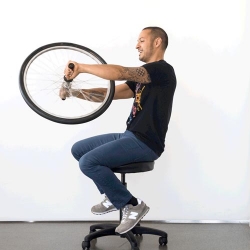
- Wow! - was Bert's surprised expression - It really works!
- Yes, the reaction of the moving wheel, or our experimental "gyroscope" is accurate!
- Explain to us better what really happened!
- Why does the wheel "refuse" to change directions when moving fast? Is it the conservation of the angular movement?
The teacher realized that he needed to give some more explanations:
- Inertia is something well known to you: just as it is difficult to take a body out of rest, it is also difficult to stop it. Everybody tends to maintain its state of movement or rest, and this is also true for a body that rotates and, in your case, what happens is more complex.
- Don't even get me started on that, in the morning, it is difficult to get my body out of "rest" and get up...
Bart knew that Bert was joking, but he still lashed at him:
- Now, this is not the kind of rest that prof. Ventura is talking ...
The teacher continued:
- Imagine the disc can rotate freely mounted in a "cardanic" system, that is, formed by rings which allow it to take any orientation. Putting the disk in fast motion, as we have already explained, it acquires a certain orientation which allows us to notice two properties.
The teacher who had searched for some images on the internet. He found one that illustrates the cardiac system, he explained with figures:
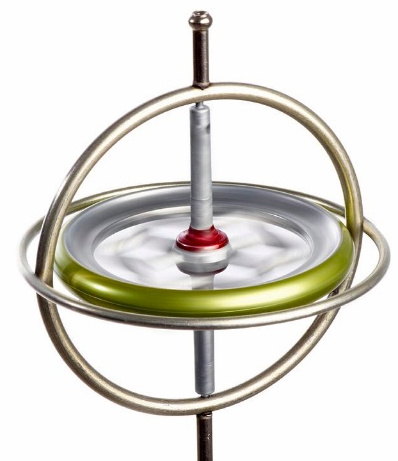
- The first is called "hardness" and consists of a strong opposition that the disk will present to any attempt to change its plane of rotation. This property will depend on three factors: the speed of rotation, the distance at which the mass is in relation to the center of rotation and the mass of the rotor.
- And the second?
- The second is called "precession" and consists of the angular change of the rotation plane, according to the influence of an external force. This precession is more complex to explain, but we can observe on a spinning top how it "reacts" to the force of gravity that tends to bring it down by making a "spiral" movement with its "head", that is, it "oscillates" in order to maintain its balance. Earth itself has this "precession" movement in such a way that the poles constantly change their position ...
- Very interesting! - Bart commented - But why does a spinning disk manifest such a force?
- In fact, forces depend on both mass and speed. If a disk is heavy and the speed is very large, the product of these quantities is even greater: the result is that the reaction forces become enormous! Imagine a disk of a few kilograms, which is not too little, but spinning at a speed of 23,000 revolutions per minute! This is a gyroscope!
- With this speed, the force of reaction to changes in the orientation of the axis of this disk must be incredible!
- Yes, - continued the professor - and this allows its use in some very interesting practical applications.
- Would it be the case of so-called "autopilots" for planes? - Bart had already read something about it and associated it with the teacher's explanations.
- In airplanes, we find a gyroscope which is activated in order to prevent small turbulences from taking it off the route, and also to help make the trip more comfortable, because with this maintenance of direction, lateral oscillations are avoided. Once connected, they can keep the plane practically in a straight line, hence they are called "autopilots" although the name is not quite proper.
Professor Ventura's explanation was interesting, but the boys wanted to know more. Bart asked:
- Besides airplanes, where else can they be used?
- They are also used on ships to reduce the problems of side swings. Since there are no reactions to changes in positions that maintain the axis orientation or the plane of the disc, the straight line or smoothly curved movement of the ship does not cause any reaction. However, the side oscillations are strongly opposed and the ship does not sway, making the trip more comfortable!
- Wow! On a transatlantic, a gyroscope must be huge! commented Bert.
Professor Ventura clarified:
- Not really! A disc of a few tons but spinning fast is enough to add a lot of comfort to passengers! Most modern passenger ships use this feature for added comfort! Like a ship gyroscope that weighs almost 500 kg and rotates at over 20,000 rpm.
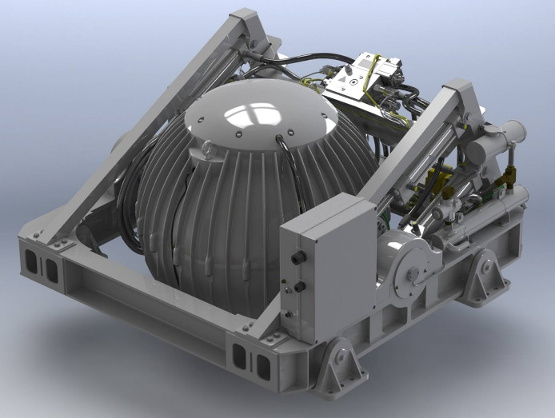
- And, back to the case of airplanes, Do modern types also use only for comfort? - it was Bart's turn to ask:
- Modern airplanes have two gyroscopes, one mounted on the tail with the axis parallel to the body of the airplane. This is the directional gyroscope that corrects small tail oscillations which tend to take the plane out of the way. Another, which is mounted on the plane's body, has its vertical axis, avoiding inclinations. These two gyroscopes are also called "displacement".
The teacher paused, and continued:
- In flight, airplanes are very light, that is, any small effort can change their trajectory, so that, to keep it on track, the gyroscopes can be very small, weighing no more than a few kilos, and that's exactly where the switch to our game is! Come with me.
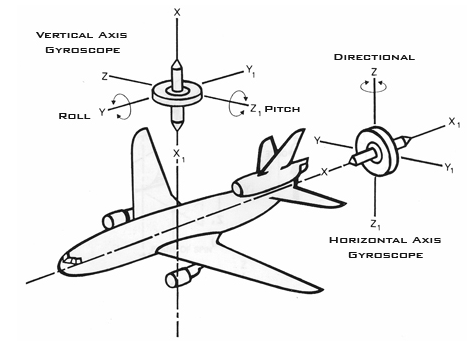
Image of the internet that Prof. used for explanations
Again, "digging" in some boxes, he removed a very curious device from the bottom of one of them.
Before the boys asked, he explained:
- It's a gyroscope...
- I suspected from the start! - interrupted Bert, parodying a childish TV hero.
The professor carried the object of some weight to the bench, where he put it carefully:
- I bought this gyroscope in a warehouse of unused aeronautical material. We have airlines which are constantly renewing their equipment and even taking aircrafts out of operation! Before dismantling, they are "plucked" with the parts that still work being sold. This gyroscope is an example: it was on an old DC-3 that was still used on the cargo lines in Amazon. This type of aircraft from World War II, besides being one of the safest, operates extraordinarily well on short dirt tracks, so to this day we still find many of them in service.
- Isn't the DC-3 the civilian version of the C-47 a bi-engine transport from World War II? - Bart showed that he really liked airplanes, because he knew the subject well.
- That's right! - confirmed the professor - But, the gyroscope 'which interests us, works at 28 Volts, which is the voltage of the aircraft's electrical system. The basic idea would be to have Hello "deliver" this business somewhere, but "working"!
- Wow! A device that has "horror" of sudden variations in position delivered by a guy"who loves "radical" maneuvers! I begin to understand the idea: Certainly the gyroscope will affect the balance of the bicycle! - Bert, finally realized the purpose of the gyroscope.
- That's right! We will provoke a "conflict of interest"! - the old master joked ...
The teacher then started to plan the complete device:
- This gyroscope works at 23,000 rpm but, for that, it requires a good current and takes a long time, something around 2 minutes, to reach the maximum speed. This means that, in addition to a good cell battery, we need to "give it some time" to get it up and running before Hello leaves with it, but this is also foreseen in the case of airplanes.
Going to the blackboard next to the bench, prof. Ventura drew a simple diagram:
- The voltage of an airplane's electrical system is 28 volts. We can achieve this with three camcorder Nicad batteries. Each supply 9.6 Volts, which results in 28.8 Volts, which is very close to the normal voltage we need. However, gyroscopes operate at 115 V x 400 Hz in a three-phase system. This tension is achieved from a "dynamotor".
Before the boys asked what that was, Professor Ventura went to another scrap box from which, after rummaging a little, he pulled out a device that looked like a small black electric motor.
- It's our lucky day! I also have a dynamotor that was part of an old radio valve on a DC-3 that I bought in the same scrap!
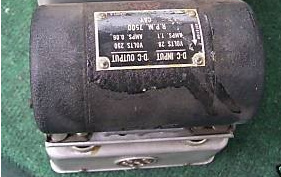
- We just need to get the DC-3 out of one of those boxes! - Bart joked.
The explanations continued:
- The dynamotor, as the name says, is a small engine powered by the plane's 28-volt but which already has the dynamo coils inside, or better a 115 V three-phase alternator that operates at 400 hertz. As the starting current is intense, and can even overload this battery, we will include a regulating circuit that operates as a limiter, applying a higher current to the dynamotor just for the interval necessary for it to start its movement. In modern systems this feature is already incorporated, applying 185 Volts at the start, but mine is a scrap from World War II and it doesn't have that!
- Is consumption that high? - asked Bart.
- Yes, but only with the engine stopped when we have almost a short circuit! So, the moment we establish the current, we need very high power to lift the heavy disk from immobility. After it reaches a few hundred revolutions per minute, the current starts to decrease. Since Nicad batteries have a very low internal resistance, and so they can supply the high currents that such a motor requires, we just need to be careful that excessive internal heating doesn't occur and ends up blowing them up! One idea is to place a supercapacitor in parallel, precisely to supply this initial starting current without causing problems to the batteries.
- Supercapacitor? - another technological novelty unknown to the boys led Bert to express doubts. The teacher explained:
- Yes, it is a type of capacitor that can store a very large load, enough to power high current devices. Capacitors of this type are used in robots as auxiliary propulsion systems and in the future they should even be used to start motor vehicles, replacing the battery in this task.
- What about the activation of the gyroscope? - It was Bert's turn to ask.
- It must be made by a relay, since the current is high, and this relay will be in a circuit that will lock it when we activate a reed-switch on the side of the "package". We just need to pass a small magnet! I believe that with the battery charge, we will need about 2 to 3 minutes for the gyroscope to reach maximum speed and then keep it that way for at least forty minutes!
The professor made some calculations involving the current during the acceleration of the disk and then the maintenance of the speed, when the consumption drops a lot.
- This means that we have little time between activation and delivery! This will require planning for the prank. - Bart was right.
- Don't worry, I already thought about that too!
After that, going from plans to assembling the "order" was not very difficult, after all the most difficult, the gyroscope was available. What would not be available in the old boxes of electronic material of Prof. Ventura?
It was only necessary to do some tests in order to get the device started without overloading the battery and then maintaining the rotation.
- Wow, how silent it is! - said Bart admiringly when he saw the device in full operation.
- Great! This is fundamental to the success of our prank! - commented Professor Ventura.
The day the prank meant to be placed was sunny and with few clouds in the sky: ideal for a good bike ride! Professor Ventura had warned his friend prof. Klas from the other school in the city, about 3 kilometers away, that he would receive a package and briefly explained the prank. Professor Klaus laughed and, on the other end of the phone line, just confirmed:
- If he gets "in one piece" up here, I get the package and then I call you!
- What? The package or Hello? - Professor Ventura joked.
- Both! - said Professor Klaus, who said goodbye and hung up the phone.
As soon as Hello was called, he rode to school, where he introduced himself to Professor Ventura. Bart and Bert were together.
- Ready for the delivery! Just tell me where ... - He immediately got his answer and was ready to take off as usual.
- Calm down! - The professor calmed him down while making a signal to Bart who was holding the box, that it was time to activate the reed-switch that started the gyroscope feeding process.
The humming that occurred inside the box was almost imperceptible, and the engine started to spin the heavy metal disk, which would soon reach close to 23,000 revolutions per minute!
Bart carefully held the box so that no sudden movement would cause the device to react.
Meanwhile, prof. Ventura explained to Hello where he was supposed to deliver, but fixing the route:
- You must go to the end of this street and then turn right, as you will be already on the main avenue! It will be easier for you to reach your destination ...
The reason for this path can be explained: the teacher wanted to see how Hello was going to make the first sharp turn at the end of the street, arriving at it at high speed, with the gyroscope already working... Bart and Bert then tied the "package" on the rump of the bicycle, being careful to leave its axis horizontal, in the direction of displacement of the set.
Otherwise, it would have no action on the curve!
Another important precaution was to tie the package very well, because otherwise it could "jump" with the effort in the curve and nothing would happen to the movement of the bicycle, except the fall of the order...
- We need to attach it very well, as this is delicate equipment! - justified Professor Ventura, testing the bonds.
Given the time required to accelerate the gyroscope, the professor released the boy on a bicycle for delivery.
As was to be expected, Hello left the place “in full”, pedaling with maximum force, and gaining speed as he walked away!
The boy did not notice anything unusual as he moved in a straight line, until a few seconds later, he reached the end of the street....
What happened is difficult to describe, both because of the speed and the multiple consequences of the action, or rather, the reaction of the "package"!
When he reached the end of the descent, Hello quickly leaned his body to the right and turned the handlebars to enter the curve with full speed!
He wanted to make the turn, but the first "conflict of interests" occurred: the gyroscope did not!
As it was firmly tied to his back, the resulting forces came into action!
The result was interesting, albeit very fast: a force arose trying to keep the bike straight while the direction in which the front wheel turned forced it in another direction.
The result was a combined force that simply lifted the rear of the bike in a strange way and launched Hello through space, in a straight line!
Inertia was at work while the bike "twisted" in a weird way!
The most interesting of all is that at the end of the curve, and Professor Ventura had predicted this (did he?), there was a small wall and on the other side a pond where there were some ducks and drakes. Hello flew over the wall and went headlong into the lake, scaring a group of ducks that, scared, dispersed with a huge noise!
The lake was shallow, so the boy was soiled more than he got wet!
A little shaken and frightened, he didn't quite understand what happened, but he didn't stop long to think: after all, the delivery needed to be made!
Quickly getting up and cleaning himself a little, he left the lake, and approaching the bicycle that was on the ground in a strange position (due to the forces of the gyroscope) he lifted it.
He found the slight resistance it expressed to this sudden movement strange but attributed it to something that would have bent in the fall! He would have time to see it later.
- The wheel must have bent!
Riding the bike again, seeing that the package was intact, Hello continued his route.
The teacher, Bart and Bert who watched everything still tried to run to the place to see if he had been injured, but there was no time.
Speeding again he reached the exit gate to the avenue.
He was supposed to "take" the main avenue to the left and he intended to do that, again with a "beautiful" curve!
But, unfortunately for him it was not just the gyroscope that should disturb him this time.
At that moment, just who was coming along the sidewalk, happily whistling a march by John Philip Sousa?
Yes, it was him: Tubald Weathercock with his tuba returning from another rehearsal by the Musical Corporation of Lemon City!
Hello saw the musician and tried to deflect, but as we know, the gyroscope prevented sudden maneuvers.
The cyclist even tried to warn Tubald!
- Hey! Get out of the way!
The bike really turned, but the same forces that had thrown the boy into the lake went into action, he flew describing a "beautiful parable" that ended right at the mouth of Tubald's tuba!
The musician even tried to deviate, but it didn't work!
With his head stuck in the tuba Hello was still screaming!
- I'm suffocating! Help!
The boy did his best to get rid of the tuba with the help of the musician, but he couldn't!
Tubald then blew with all his strength, producing a strong note that helped the boy to fall backwards on the sidewalk!
A small agglomeration was already forming on the spot!
Professor Ventura, Bart and Bert spied, hidden behind the pillar of the school gate!
But that was still not enough to prevent the delivery man from proceeding.
Without observing the strange position in which the bicycle "contorted" by the action of the gyroscope, verifying that the package was intact, he rode and pedaled hard apologizing for the inconvenience!
Tubald was just checking that there was no "damage" to his precious instrument!
After several falls in curves, finally the more moderate boy arrived at the entrance:
- Wow! What a difficult delivery! It isn't my lucky day!
- It's just that you speed too much! - observed Professor Klaus.
- I think you're right! - agreed Hello.
The teacher then thought that he had managed to correct the tireless raced with this, but he was mistaken, as he added:
- Next time I come with padded clothes to protect me from falling! Protected I can even speed more!
The incorrigible "racer" left under Professor Klaus' incredulous gaze.
Taking the package inside, which was carefully removed by himself, as instructed by Professor Ventura, Professor Klaus prepared to call without knowing that the two were going there.
However, he carelessly left the gyroscope in his parlor.
It was now when Professor Ventura, Bart and Bert arrived and were entering the other school, a strong woman's cry was heard:
- Hey!
Running to the parlor they could see the scared cleaning lady on a chair, hitting the package containing the gyroscope with a broom!
- This "thing" is alive! Get it out of here! When I tried to get it off the floor it "escaped" from my hand and started dancing!
Professor Ventura, Bart, Bert and Professor Klaus laughing saw the package performing a strange "dance" on the floor under the terrified look of the poor woman. They, then, carried the "package" away without her understanding what was going on.



